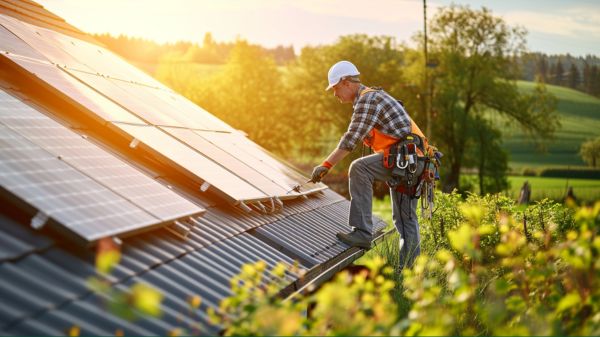Why Is Solar Power Grid Integration Challenging?
Have you ever wondered why solar power grid integration is such a challenge? Well, buckle up because we’re about to dive into the technicalities. From grid instability to limited capacity, there are several factors that make this integration a complex task.
In this article, we will analyze the intricate web of regulations and policies, as well as the difficulties posed by intermittent solar generation.
So, let’s explore why achieving seamless solar power integration into the grid is no walk in the park.
Key Takeaways
- Fluctuating solar power output leads to grid instability and voltage control issues.
- Lack of grid infrastructure, including transmission lines and substations, hinders the integration of solar power.
- Limited grid capacity for solar energy due to congestion and transmission constraints.
- Complex grid regulations and policies, including varying interconnection standards and net metering policies, create challenges for solar power integration.
Grid Instability and Fluctuating Solar Power
Fluctuating solar power and grid instability pose significant challenges in integrating solar power into the grid. Grid balancing, which involves managing the supply and demand of electricity, becomes more complex when solar power is added to the mix.
Solar energy production is highly dependent on factors such as weather conditions and time of day, resulting in fluctuations in power output. This variability can lead to voltage control issues, as the grid must maintain a stable voltage to ensure reliable operation of electrical devices.
To address these challenges, various techniques are employed, including energy storage systems, smart grid technologies, and advanced control algorithms. These solutions help stabilize the grid by storing excess solar energy and releasing it during periods of low generation.
Additionally, voltage control devices and strategies are implemented to regulate voltage levels and maintain grid stability.
Lack of Grid Infrastructure for Solar Integration
To successfully integrate solar power into the grid, you need to address the challenge of a lack of infrastructure for solar integration. This lack of grid infrastructure hinders the efficient adoption of renewable energy sources.
Here are some key factors contributing to the challenge:
- Insufficient transmission lines: The existing grid infrastructure isn’t designed to handle the increased capacity of solar power generation. Without an expansion of transmission lines, it becomes difficult to transport solar energy from remote areas to population centers.
- Limited substations: As solar installations increase, the number of substations needs to be expanded to accommodate the additional power flow. This lack of substations can lead to grid congestion and instability.
- Inadequate grid storage: Without sufficient grid storage, excess solar power can’t be stored for later use, resulting in potential waste of renewable energy.
- Outdated grid management systems: Traditional grid management systems may not have the capabilities to effectively monitor and control the integration of solar power, leading to technical challenges and operational inefficiencies.
- Lack of interconnection standards: The absence of standardized interconnection protocols makes it challenging for solar power systems to seamlessly integrate with the existing grid infrastructure.
Addressing these issues through grid expansion and improved renewable energy integration strategies is crucial to overcome the lack of infrastructure and successfully integrate solar power into the grid.
Limited Grid Capacity for Solar Energy
You need to address the challenge of limited grid capacity for solar energy, which can hinder the efficient integration of solar power into the grid.
Grid congestion and transmission constraints are major factors contributing to this limitation.
Grid congestion occurs when the existing transmission infrastructure is unable to accommodate the increasing amount of solar power being generated. This can result in bottlenecks and restrictions in the flow of electricity from solar installations to the grid.
Transmission constraints, on the other hand, refer to the physical limitations of the transmission lines to carry the high volumes of solar energy. These constraints can be due to technical limitations or geographical factors.
To overcome these challenges, investments in grid infrastructure upgrades and expansions are needed to increase the capacity and flexibility of the grid to handle higher amounts of solar power.
Complex Grid Regulations and Policies
Navigating the complexities of regulations and policies can pose significant challenges when integrating solar power into the grid. The grid management and technical barriers associated with complex grid regulations and policies can hinder the smooth integration of solar energy.
Here are some key factors that contribute to these challenges:
- Interconnection standards: Different regions have varying interconnection standards, making it difficult to establish uniform guidelines for solar power integration.
- Net metering policies: Inconsistent net metering policies across jurisdictions can create uncertainty for solar power producers and consumers.
- Grid integration studies: Conducting comprehensive grid integration studies is essential to determine the impact of solar power on the grid, but these studies require substantial time and resources.
- Regulatory approval processes: Obtaining regulatory approvals for solar power projects can be time-consuming and complex, adding delays to the integration process.
- Market structure: The existing market structure may not adequately incentivize grid operators to accommodate large-scale solar power integration.
Addressing these complex grid regulations and policies is crucial to ensure the efficient and widespread integration of solar energy into the grid.
Integration Challenges With Intermittent Solar Generation
One of the major challenges faced when integrating solar power into the grid is dealing with the intermittent nature of solar generation. Solar energy production is highly dependent on environmental factors such as sunlight availability and weather conditions, resulting in fluctuations in power output.
This intermittency poses difficulties for grid operators in maintaining a stable and reliable electricity supply. To address this challenge, renewable energy subsidies have been implemented to incentivize the adoption of solar power storage solutions.
These solutions allow excess solar energy to be stored and used during periods of low or no solar generation, helping to balance supply and demand and reduce dependence on fossil fuel-based backup power sources. However, the high costs associated with solar power storage systems and the limited storage capacity remain significant barriers to achieving effective integration of intermittent solar generation into the grid.
Conclusion
Integrating solar power into the grid poses numerous challenges. The instability and fluctuation of solar power, coupled with a lack of infrastructure and limited capacity, make it difficult to achieve seamless integration.
Additionally, complex grid regulations and policies further complicate the process. The intermittent nature of solar generation adds another layer of complexity.
Despite these challenges, however, advancements in technology and policy can help overcome these obstacles and pave the way for a more sustainable and reliable solar power grid integration.






